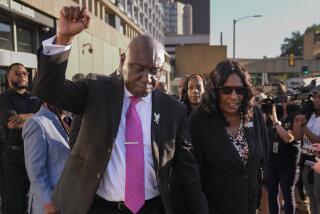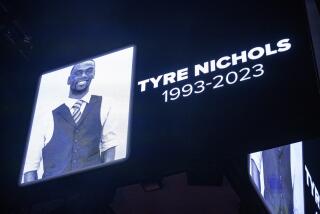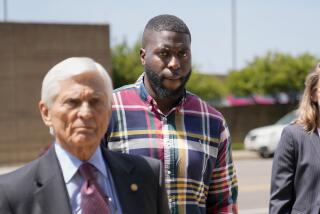Oklahoma City Defendant Plans to Prove Conspiracy
DENVER — The attorney for Oklahoma City bombing suspect Terry L. Nichols, in a major departure from the defense used by convicted co-defendant Timothy J. McVeigh, argued Monday that other collaborators were involved and promised to prove that his client was merely a pawn in a larger conspiracy.
“Timothy McVeigh was not alone,” Michael Tigar told the jury in opening statements at Nichols’ trial. “With him in the cab of that truck were one or two other people. And, yes, Terry Nichols was not there, and did not know about the bombing until the next day.
“I am going to describe the results of our investigation into the Oklahoma City bombing,” he added. “How Timothy McVeigh planned this crime, who he planned it with and how they helped him, people he used and lied to and people he put under unjustified suspicion.”
Although Tigar, one of the nation’s premier criminal defense lawyers, never said who the other conspirators were, his claim plainly demonstrates just how different Nichols’ defense will be from McVeigh’s.
It also appears likely to provide at least a partial look at the conspiracy theories that have sprung up around the bombing, some of which are now being explored by an Oklahoma City grand jury but were not examined in any depth during McVeigh’s trial earlier this year.
McVeigh’s attorneys were barred by the judge from presenting much evidence about possible collaborators. In addition, McVeigh’s role as the mastermind of the terrorist act put him at the center of any alleged conspiracy. Thus, showing that others were involved would not have established his innocence.
In the end, McVeigh was found guilty and sentenced to death.
Apparently at the heart of Nichols’ defense is the fact that he was not in Oklahoma City on the morning of the bombing. Building on that, Tigar argued Monday that his client’s involvement came about because McVeigh used him and others to commit the crime.
The government has insisted that McVeigh and Nichols alone carried out the planning and preparation for the bombing of the Alfred P. Murrah Federal Building, which took 168 lives in the worst terrorist attack in this country.
*
Chief prosecutor Larry Mackey, in his opening statement, outlined evidence that he said will tie Nichols, 42, and McVeigh, 29, to the April 19, 1995, explosion. He gave jurors a deliberate and detailed overview, although it largely covered ground familiar to those who have followed the cases closely.
Together, Mackey said, McVeigh and Nichols purchased ammonium nitrate, barrels and other bomb components, then mixed the ingredients at a Kansas fishing lake the day before the bombing.
In addition, he said, Nichols and McVeigh stole blasting caps from a Kansas quarry and Nichols, acting at McVeigh’s behest, took guns and precious coins and jewels from an Arkansas horse farmer in a robbery. Proceeds from that crime allegedly helped pay for bomb ingredients.
Mackey conceded that Nichols was at home in Kansas the morning of the explosion but argued that his association with McVeigh makes him just as guilty. And he said the prosecution team will show that, several days before the bombing, Nichols helped McVeigh plant a getaway car in Oklahoma City.
“Terry Nichols had been side-by-side with Timothy McVeigh in their plan of violence,” Mackey said. “He was there at the beginning to acquire the bomb ingredients, and he was there at the end to stash Timothy McVeigh’s getaway car.”
If convicted by the jury of seven women and five men, Nichols also could receive the death penalty.
Nichols sat ramrod straight in the courtroom, dressed in a light blue button-down shirt and dark blue blazer. Occasionally Tigar, sitting next to him, rested his hand on Nichols’ shoulder.
In Tigar’s opening remarks, he kept the hot light on McVeigh, painting him as a man driven by hatred for the government who was adept at using others to further his goals.
For instance, he contended that Nichols did not help McVeigh mix the bomb but, rather, had permitted McVeigh to borrow his pickup truck on the day the ammonium nitrate and fuel oil was blended together and then packed inside barrels in a Ryder rental truck.
He strongly suggested that others were deeply involved--although none have ever been identified.
For instance, he said, half-a-dozen witnesses in downtown Oklahoma City remember seeing McVeigh with someone else in the Ryder truck the morning of the blast.
Tigar raised the specter of John Doe No. 2, a second suspect who reportedly was with McVeigh when he rented the truck but who has never been linked to the crime. Tigar suggested that John Doe No. 2 was one of these main players in the scheme with McVeigh.
Others Tigar mentioned included Roger Moore, the Arkansas horseman whose guns and valuables were taken. Moore shared McVeigh’s deep distrust of the federal government. Shortly before the bombing, Tigar noted, Moore wrote a coded letter to McVeigh in which he talked about their being “safe from satellites.”
Tigar said that McVeigh’s Kingman, Ariz., friends, Michael and Lori Fortier, traded information with the government so they would not be charged in the bombing. He described a scene on a motel balcony in Oklahoma City where the Fortiers were staying in which Michael Fortier desperately tried to make a deal with federal agents for immunity if he would help convict McVeigh.
The agents told him: “Son, we’ve already got Timothy McVeigh. If you’re going to get immunity, you’ll have to give us somebody else,” Tigar said.
That somebody else, Tigar said, became Nichols. In return, Michael Fortier was never charged in connection with the bombing, although he was imprisoned for transporting the guns stolen from Moore. Lori Fortier has not been prosecuted.
Tigar also contended that a series of statements Nichols gave the FBI during a 9 1/2-hour session after his surrender were made in good faith, even though federal agents concealed from him their plan to arrest him in the bombing anyway.
“Terry Nichols told the truth,” Tigar said, “even as the FBI lied to him, lied to his family and lied to the court.”
*
And Tigar said that, while McVeigh criss-crossed the country in the months before the bombing, Nichols had moved his family to central Kansas and was attempting to put down roots.
“Terry Nichols was building a life, not a bomb,” Tigar said.
Tigar’s descriptions are likely to fan the conspiracy theories that have grown up around the case.
Kathy Wilborn, who lost two small grandsons in the bombing and whose family has worked hard at finding others who might have been involved, said during a court break Monday that she welcomes Tigar’s attempts to cast a wider net.
“I’m real pleased,” she said. “I’m glad they’re bringing John Doe No. 2 up. I hope they bring them all to the party.”
More to Read
Sign up for Essential California
The most important California stories and recommendations in your inbox every morning.
You may occasionally receive promotional content from the Los Angeles Times.











